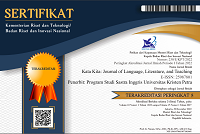CONTRADICTORY CHARACTER TRAITS AS SEEN IN PERSONA 4: THE ANIMATION
DOI:
https://doi.org/10.9744/katakita.3.4.33-38Abstract
Anime is Japanese cartoon that has a vast popularity due to its story and art. The popularity of anime results in the various genres such as: crime-fiction, urban fantasy, and slice of life. One of the popular animes that combines the three genres is Persona 4: the Animation. The popularity and the combination of three genres of that anime makes me interested in analyzing this anime. I am particularly attracted to the two main characters in Persona 4: The Animation namely, Yu Narukami and Tohru Adachi. Those two main character possess contradictory character traits and represent a certain symbol on the society. In this paper, I examine the values that influence their character traits. Using Carl Gustav Jung’s theory of individuation, I proves that they have contradictory character traits by looking through their Persona, Shadow, Ego, and Self. Through the analysis of character traits, I find that they symbolize yin yang. Like yin yang, they are contradicting as well as complementing. Yet, they also are not paragon of evil or goodReferences
Guying, C. (1983) Zhuangzi. Beijing: Chinese Press.
Jung, C. G. (1989a). Memories, Dreams, Reflections (Rev. ed., C. Winston & R. Winston, Trans.) (A. Jaffe, Ed.). New York: Random House, Inc.
Jung, C. G. (1989b). Psychology and Religion: West and East (2nd ed., R. F. C. Hull, Trans.). Princeton, NJ: Princeton University Press.
Jung, C. G. (1962). Symbols of Transformation: An analysis of the prelude to a case of schizophrenia (Vol. 2, R. F. C. Hull, Trans.). New York: Harper & Brothers.
Jung, C. G. (1953). Two Essays on Analytical Psychology. London: Routledge.
Downloads
Issue
Section
License
Authors who publish with this journal agree to the following terms:- Authors retain copyright and grant the journal right of first publication with the work simultaneously licensed under a Creative Commons Attribution License that allows others to share the work with an acknowledgement of the work's authorship and initial publication in this journal.
- Authors are able to enter into separate, additional contractual arrangements for the non-exclusive distribution of the journal's published version of the work (e.g., post it to an institutional repository or publish it in a book), with an acknowledgement of its initial publication in this journal.
- Authors are permitted and encouraged to post their work online (e.g., in institutional repositories or on their website) prior to and during the submission process, as it can lead to productive exchanges, as well as earlier and greater citation of published work (See The Effect of Open Access).














